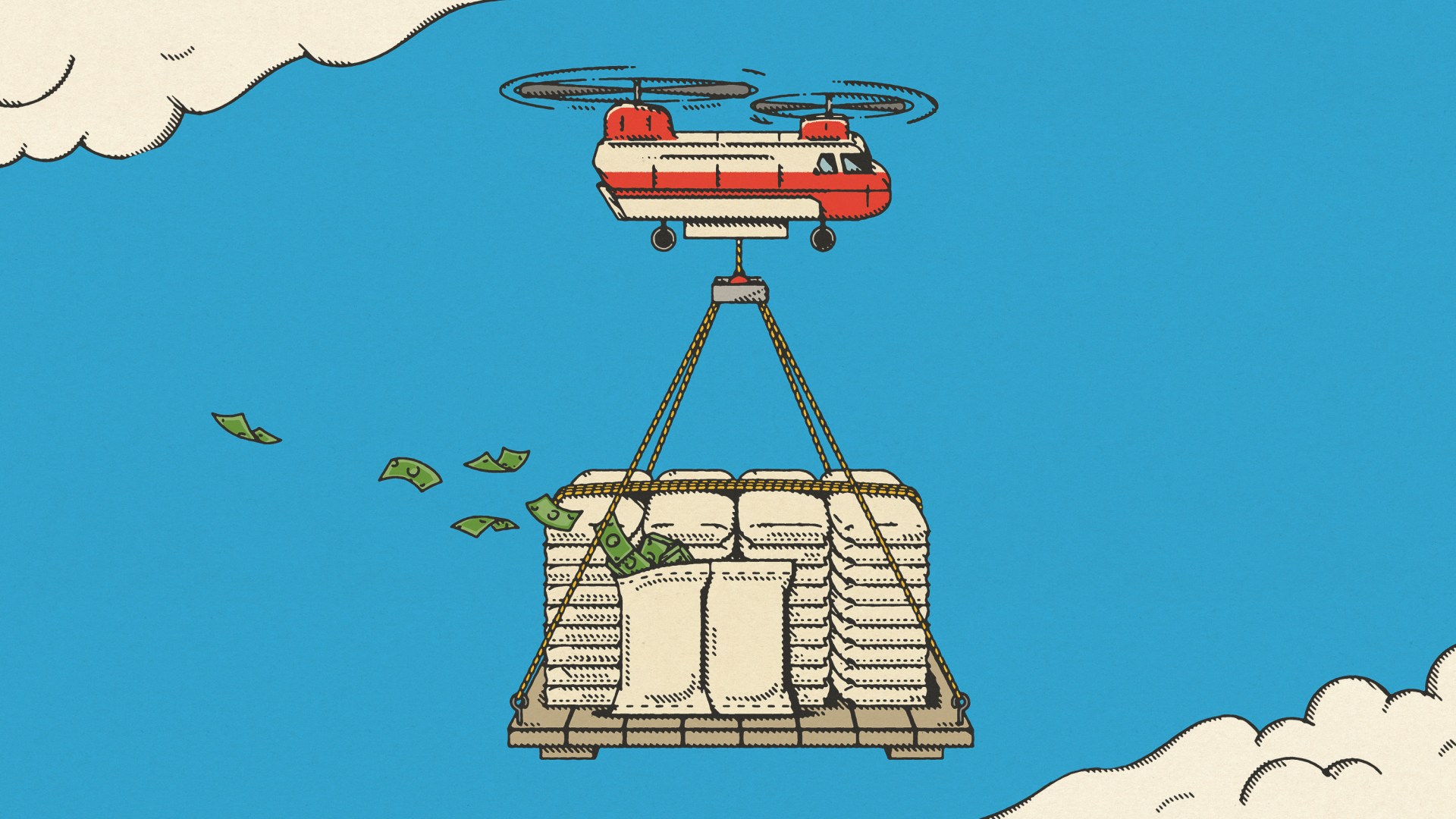Agya Afari in Dodowa, Ghana, turns the corn and cassava dough in a pan perched on a coal pot as his middle child fans the coals. Nearby, his wife, Yaa Manu, grinds pepper, tomato, and onion to make a sauce for supper. The only form of protein, two boiled eggs, is traditionally reserved for the adults in the household.
“This has become a way of life for us lately—banku and boiled eggs with ground pepper,” Afari laments in Twi. “Limited work in this current economy, increasing prices, and a pest invasion on our farm means my family and I have been struggling to make ends meet. One daily meal that satisfies everyone is impossible,” he adds.
This may seem like a timeless story of food insecurity. But Afari’s family is affected by the most widespread global hunger crisis on record. In the past couple of years, the need for food aid has more than doubled, with the World Food Program estimating that today 345 million people are close to starvation. World Vision estimates that one in five Africans suffered from hunger in 2020 and that over the past two years, the situation has only worsened.
In West Africa, 151 million people didn’t have enough food in August of 2022, according to the World Food Program. In East Africa (particularly the Horn of Africa), it estimated, 79 million people needed food. Without strategic help, their suffering will be deepened and prolonged.
But strategic help hasn’t always been the rule. In fact, Christian aid agencies have significantly changed the way they provide food assistance over recent decades to adjust to some difficult lessons.
During the well-publicized Ethiopian famine in the 1980s, relief consisted mainly of the direct delivery of food from donor countries.
“Who we are and what we do as Christian aid agencies has evolved,” says Malvern Chikanya, the country director of Food for the Hungry Uganda. New strategies have emerged in the past 30 years based on the recognition that food insecurity isn’t actually solved with food.
Instead, Christian organizations say, famine is caused by people’s broken relationships and fragile communities. Food helps people survive an emergency, but it takes far more to restore their livelihoods, safety, and health. As a result of this understanding, aid organizations are changing the forms of relief they offer, improving their ability to anticipate food insecurity, and seeking guidance from a theology of development.
Neither famine nor today’s approaches to aid are primarily about a lack of food. There is enough food produced in the world to feed everyone. Famine has to do with food not reaching people at the right time, due to failures in some of the systems they depend on for safety, livelihood, transportation, and so on.
Famine is primarily a political problem. It reveals fragility in governance. Fragile political contexts are usually hungry contexts, with high rates of disease, neonatal and maternal death, and children out of school.
In sub-Saharan Africa, the past few years have brought more hardship than expected, with unusual stressors like drought, locust invasions, the COVID-19 pandemic, and an extreme grain shortage caused by Russia’s invasion of Ukraine.
But one cause of famine dominates: conflict. World Vision regional security director Johan Eldebo says famine is far more often caused by manmade situations, such as armed conflict, than by natural disasters. One way fighting causes famine is by forcing noncombatants to flee. “Conflict uproots people from their homes and farmland, disrupting production and productivity, destroying livelihoods and supply chain systems which play an important role in food production and marketing,” explains Joseph Kamara, regional humanitarian and emergency affairs director for World Vision in East Africa.
In Nigeria, Boko Haram and other armed groups kidnap large groups of people. In 2020, kidnappings skyrocketed to about one event per day. Vehicles transporting food to market are unsafe on the roads, so much normal trade is fraught. Boko Haram’s activities also mean people are afraid to work their fields, knowing they risk being attacked by bandits. With fewer crops produced and brought to market, prices go up. The demand for imports does, too—making food shortages a valuable tool for enriching kidnappers.
Nevertheless, “you can have hunger without conflict,” Kamara says. He pointed to countries, including Malawi, Zambia, and Angola, without widespread conflict that are nevertheless experiencing widespread hunger “due to climate change and the challenges of the pandemic, [which have] made an already tough economy more difficult.”
Just as famine’s causes are complex, so are its consequences. A food crisis is officially classified as a “famine” when more than 30 percent of children in an area are starving and when at least two deaths per 10,000 people are credited to hunger. For many people, news of a food crisis or famine brings to mind deaths directly caused by starvation, especially among babies and children, those already sick, and older adults. But this is only part of the toll famine takes.
Children who do not receive adequate nutrition in their early years face lifelong consequences. The clearest symptom of this chronic malnutrition is stunted growth, but long-term hunger’s invisible symptoms are also quite serious, including impaired cognitive development and compromised immune systems.
Desperate heads of households may make life-altering decisions for their families, such as giving underage girls in marriage with the hope that the bride price will provide their family enough money for necessities.
In one such case, Kamara says, “We asked the parent why, and they said, ‘What would you do, if you were me? You have nothing left and are now seeing your children being wasted. What would you do?’ ” As the medical journal The Lancet pointed out, girls who are married are at much higher risk of dying in childbirth, contracting HIV, and being abused. But for parents who feel their family cannot survive without a bride price, “those are very hard choices,” Kamara says.
Disease follows famine. Most severely malnourished children also have infections. In famine-impacted areas, measles, pneumonia, malaria, tuberculosis, and HIV outbreaks are to be expected.
Famines destroy livelihoods, especially for those who depend heavily on farming or herding. Community is also lost, as hungry people move farther from home in search of food and work, often splitting up families.
 Illustration by Mike Haddad
Illustration by Mike HaddadFor a hungry individual, free food can be lifesaving. But for a food-insecure community, food is only one of many elements needed to recover.
The relief aid that used to consist mostly of the delivery of food and ingredients is giving way to a focus on long-term food-security measures. Now, Christian aid agencies aim to bolster local food production and economies, whenever possible.
Where markets are functional, distributing cash instead of food enables hungry families to buy what they need and support the local economy. Also, GSMA, a mobile network association, estimates that half of sub-Saharan Africa’s population will be subscribing to mobile services by 2025, so phone-based money transfers are often possible. In areas where cash transfers are not feasible, “we distribute vouchers that can be redeemed for cash, the beneficiary takes the voucher to the vendor, who exchanges it for food items of an agreed-upon value. The vendor brings the voucher to World Vision for redemption,” says Kamara.
These methods have the additional merit of giving dignity to people whose identity as providers has been undermined by a sense of helplessness. They are also designed to build resilience, so communities can quickly handle shocks such as a long-term drought.
The changes in how aid agencies respond to famine are helping, but sometimes they aren’t enough. Food drops are dramatic and often lifesaving, and they still continue.
However, food drops are risky, as well as expensive. Aid agencies have seen significant problems develop when food drops are used as the main solution to hunger. Several international development professionals reported that, in the past, assistance had been delivered in a way that undermined the long-term food security and general development of the very people they were trying to serve. In some cases, these problems disrupted the local economy or disturbed community stability, making another famine more likely.
In Haiti, for example, farmers are still struggling to make a living growing rice because of the massive influx of rice aid from the US following the 2010 earthquake. In Yemen in 2019, repeated instances of violent unrest caused the UN to stop its food aid deliveries until Houthis, a rebel group that controls a significant part of the country, guaranteed they would stop hijacking them.
In many countries, armed groups—including government forces—have diverted food aid from starving people, or taxed or sold food aid, using the aid to further violent conflicts. Corrupt officials skim aid money and send it to their private foreign bank accounts.
These problems are ongoing. In Somalia, for example, militants blocking food-aid groups’ access to villages will likely lead to more hunger and deaths from starvation.
Poor communication and lack of cultural understanding can also lead to trouble when in-kind food aid arrives, failing to effectively help some of the hungriest and most vulnerable people. In one report on Zimbabwe, distribution of food aid resulted in physical fights and community conflict over accusations of fraud, as well as the exclusion of orphans and the families of single mothers (who are locally considered minors).
Many Christian relief and development groups now turn to collaborative solution-seeking with local communities before anything goes wrong.
Chikanya says that building mutual understanding is a priority for Food for the Hungry’s food assistance. “For instance,” he says, “when we enter any community, we start by building relationships and trust with the people we seek to serve at various levels.”
World Vision does this through its community-based targeting and distribution, a process where the affected community makes a list identifying those among them most in need of aid. When the final list is vetted, World Vision transports food to an agreed-upon place at an agreed-upon time.
“The recipients then proceed to a distribution area, where they receive their rations, counterweigh them for accuracy, sign the list to acknowledge receipt, and then exit the distribution area and meet their family members, who accompany them to help carry the food home,” explains Kamara.
There is even a complaints desk. Kamara says creating a continuous feedback loop to hear firsthand from the community is vital to the process. However, they are not the only voices Christian aid groups must listen to.
The US government is the world’s largest food aid donor, sending over 50 percent of global food aid. Some Christian organizations, including World Vision, receive grants through the United States and other governments, often with strings attached. Half of in-kind food aid from the US government, for example, must be shipped on US carriers, which increases costs.
Many Christian aid organizations work in tandem with the World Food Program and the governments of the countries they seek to help. Often, gaining access to people in need and the resources to help them depends on abiding by the rules put forth by local governments and the World Food Program. This is sometimes true even when Christian organizations deliver assistance in some of the most remote parts of the world—places where other aid organizations are often absent.
A significant change in providing food aid is the world’s increasing ability to prevent famine or to nip it in the bud.
The Ethiopian famine of the 1980s caught aid agencies unaware. Kamara says Christian aid groups “did not have the logistical systems we have today to prevent the crisis.”
In contrast, today many organizations have access to ongoing analysis of food security and other contributing factors. This type of analysis has demonstrated the interconnection between fragility and food insecurity. In fact, in 2018, every single country that had a chronic food crisis also had violent conflict.
In 2017, a famine was predicted in Somalia. World Vision and other relief agencies worked proactively to target areas expected to be hardest hit, screening children for malnutrition, providing food and vitamins, and funding health clinics. As anticipated, the conditions were indeed extremely bad, with people dying of starvation and billions of assets, such as livestock, destroyed.
Prevention is a less dramatic yet more effective way to help. Christian and other aid agencies can mitigate the shock of famine by monitoring various hot spots across the globe. Data analysis can often highlight potential problems.
“World Vision’s Fragile Context Program Approach acknowledges this and designs programs in anticipation of what might come next, so that we can respond to a problem before it becomes a crisis,” Eldebo says. “This also helps the safety of aid agencies as well as children and communities in need.”
If he could go back in time and change the assistance Christian relief organizations provided to Ethiopia in 1984, Kamara says, it “would have been to deal with the causes and not just the symptoms” of the famine.
Christian organizations are not the only groups now seeking to deliver food assistance that supports local economies, de-escalates conflicts, and keeps long-term goals in mind. But Christian groups are helping in a distinctive way by also recognizing the spiritual and relational components of famine.
Consensus-building within and among aid groups has led this change, although various sources told CT it was sometimes contentious. In question was the best way—if at all—to differentiate missions and development. Should evangelism and social action always be concurrent? Should they always be separate? What actions wrongly exploit the desperation of people looking for help?
Further, groups wrestled with external expectations, such as those who thought Christians should tie much-needed support to aid recipients’ conversion to Christianity or others who wanted Christian organizations to take the same stance as secular and government organizations on contentious issues such as abortion.
Debates around these issues are not new. A 1982 Lausanne report overseen by John Stott called “Evangelism and Social Responsibility: An Evangelical Commitment” lays out some of the tensions aid groups experience. White papers from the Wheaton ’83 conference and others followed. They built an intellectual and pastoral foundation for today’s famine aid.
In recent years, Christian organizations have adopted statements of development theology. Like a statement of faith, a statement of development theology articulates an organization’s core values based on biblical principles.
Development theology puts the emphasis of relief work on understanding humanity and not just on managing supplies.
While some theories guiding relief efforts pin blame for food insecurity solely on one contributing factor, such as climate change or ethnic conflict, Chikanya explains, “Food for the Hungry regards poverty as a result of broken relationships—between God and man, man and man, man and himself, and man and nature.”
Chikanya says, “This holistic view of poverty underpins how Food for the Hungry designs its programs, focusing on building and restoring relationships at different levels using both biblical principles and evidence from behavioral sciences.”
Development theology accounts for the facts of food insecurity while also emphasizing the need for regeneration. It places community relationships and personhood at the center of famine relief. All people involved in the aid process, whether donors, bureaucrats, aid workers, community leaders, or recipients, are part of God’s good creation.
Today’s food-security problems are unlikely to be resolved quickly or easily.
Ray Hasan, Christian Aid’s head of Asia, Middle East, Latin America, Caribbean and global programs, recently said, “The rocketing price rises for food and fuel that we are currently experiencing are having serious impacts on our work.” Since food is much more expensive, “sometimes we must cut back on certain items like oil, so that we can help more people with the basics.” But in-kind food aid isn’t the only form falling short, Hasan said “Cash distributions are less meaningful than they used to be.”
Disruptions in supply chains, crop losses, unstable weather, and insufficient rains eroded the incomes of almost all households in affected areas of East Africa. But relief in these circumstances isn’t in sight. Based on current data, Kamara says that “weather conditions are not going to improve.” He adds, “Crops are likely to fail again, and that will be catastrophic for our region.”
So in addition to newer efforts, Christian aid agencies have also needed to resort to direct food delivery. For people in emergencies, especially those in sub-Saharan Africa, this food aid has been a lifeline to getting the right nutrition for survival.
This current situation is, in some ways, just the short-term crisis pointing toward larger challenges to come. The Sahara desert is expanding, eroding arable land.
Climate shocks, like the previously rare tropical cyclones that hit Mozambique in 2021 and 2022, are likely to accelerate. Kamara says, “We are experiencing more warmer months than before, and rainfall has significantly reduced, with more drought periods which have become long, intense, and more frequent.”
Conflict, too, seems unlikely to be resolved in a matter of months or even years. Long-term peace-building is now part of the work of preventing famine.
Famine relief begins not when emergencies arise but before, in deliberations and negotiations. The role of local churches and leaders in addressing food crises will likely grow. “Engaging local first responders such as local churches, government authorities, and community-based organizations and developing their capacity will be critical for now and the future of famine prevention,” says Chikanya.
According to Eugene Cho, president and CEO of Bread for the World, Christian food aid plans should “acknowledge that direct relief is important when someone is hungry but bigger-picture issues demand policies that affect development.”
What might seem so simple—giving food to the starving—is as complex as any community. “We need to continue to remain engaged, to remain prayerful, to remain generous, to amplify our voices, to advocate for our sisters and brothers, both in our nation and around the world,” Cho says.
Ama Akuamoah is a strategist based in Accra, Ghana, focusing on communication, program management, African governance, and international development.











